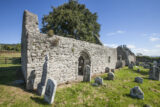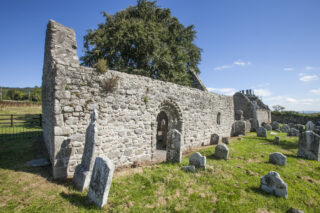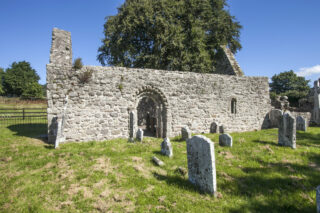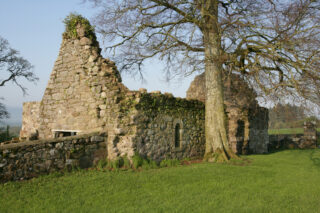Fógra
WARNING: It should be noted that these sites are unguided and a level of care and caution should be maintained during all stages of your visit. The Office Of Public Works (OPW) will not be held responsible for any damages, injuries, or losses that occur
Kilcash Church
Kilcash Church and graveyard lies south-east of Slievenamon Bog in the village of Kilcash. The church is sited on the monastic foundation of 6th century Irish saint Colmán ua hEirc. The church, circa 1190-1200, was granted by Baldwin Niger to the Fratres Cruciferi hospital of the Priory of St John the Baptist. The transfer of ownership was not confirmed until 1353, by the Bishop of Lismore. In 1389 Kilcash Church was enlarged. After the Dissolution of the Monasteries, John White leased the church.
In 1656 the church was noted to have still been roofed. The church was built using blocks of sandstone. Possible remains of an original antae can be found in the rebuilt north wall. The original western doorway was replaced by a chancel arch joining the newly built nave. Entry to the nave was via the Romanesque sandstone doorway. The doorway shows three decorative orders, including chevrons. Light to the nave was provided by two round-headed sandstone single-lit windows. Very worn architectural fragments remain, including Romanesque decoration, in the nave.
Kilcash graveyard contains headstones dating to the 17th century. Headstones from the 18th century show elaborate carved designs of the Crucifixion. The mausoleum at the northern end of the graveyard was built by the Butler family in the late 17th / early 18th century. Interred within the mausoleum are Col. Thomas Butler of Kilcash (d.1738), Lady Iveagh Margaret Butler (d. 1744), Archbishop of Cashel Christopher Butler (d. 1757), 16th Earl of Ormond Walter Butler (d. 1773) and 17th Earl of Ormond John Butler (d. 1795). The mausoleum was sealed in 1991.
Visit Historic Environment Viewer for more information on Kilcash Church
Protect our Past - Click here to read about the importance of protecting our country’s unique heritage sites
This national monument is protected in accordance with the National Monuments Acts 1930 to 2014




